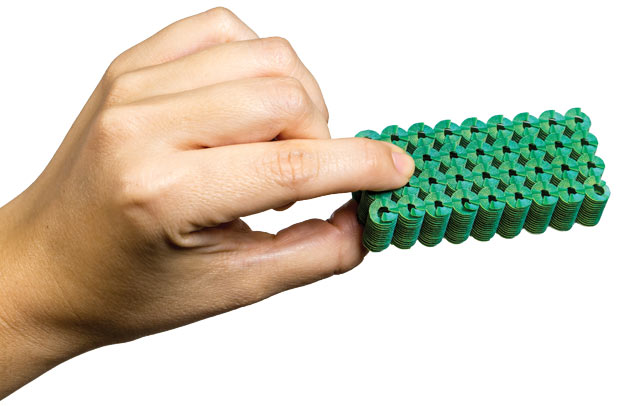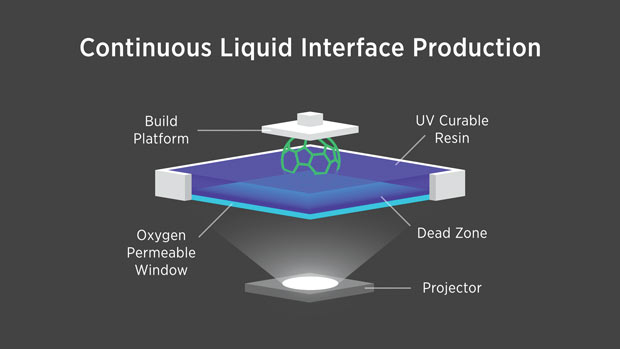
HP Multi Jet Fusion technology part sample printed on HP 3D printer laboratory prototypes. Images courtesy of HP.
Latest News
May 2, 2016
 Carbon (formerly Carbon3D) uses a 3D printing method called Continuous Liquid Interface Production (CLIP). It allows its hardware to “grow” a part out of liquid materials, in a manner of speaking. Image courtesy of Carbon.
Carbon (formerly Carbon3D) uses a 3D printing method called Continuous Liquid Interface Production (CLIP). It allows its hardware to “grow” a part out of liquid materials, in a manner of speaking. Image courtesy of Carbon.In his TED Talk titled “What if 3D Printing Was 100x Faster?”, Carbon’s CEO and co-founder Joseph DeSimone remarked: “3D printing takes forever. There are mushrooms that grow faster than 3D printed parts.” The tech-savvy TED audience greeted it with an outburst of knowing laughter.
DeSimone, a chemistry professor, wants to speed up 3D printing by “marrying the intricacies of molecular science with hardware and software technologies.” The result—a process that grows parts out of a pool of liquid material Carbon calls CLIP (Continuous Liquid Interface Production).
In 2015, when it emerged from stealth mode, the Redwood City-based Carbon got a $10 million boost from 50 miles north, from the San Rafael-headquartered design software giant Autodesk. Aside from investing in its own additive manufacturing (AM) initiatives, Autodesk also supports burgeoning, promising R&D in AM with its Spark Investment Fund.
This March, in a special event Autodesk organized at its Pier 9 workshop by the San Francisco Bay, Pierre Lin, the lead engineer for Autodesk’s Ember 3D printer, showed rapid prototyping could be truly rapid.
“This print job usually takes overnight to finish,” he said, pointing at an intricate lattice structure the size of a thermos. “I’m going to see if I can get it to print in Ember in less than the time it takes me to finish my presentation.” His presentation would run roughly 15 minutes.
The source file for the print job was a STL file, measuring 63.5x39.5x133.5 mm, with 314,928 polygons. Lin explained how he was able to dramatically accelerate the print job: “Based on the geometry, I modified the print settings to optimize the printing speed. In order to optimize the print settings, I need to thoroughly understand the hardware and material limitation,” he said. One way to overcome the speed bottleneck is to “give the customers the ability to develop their own solution and workflow,” proposes Lin; something possible only under the open source model.
The existing crop of AM hardware and software are more than adequate to build one-of-a-kind prototypes, to satisfy the needs of consumers, hobbyists and enthusiasts. But to earn a broader spot in industrial operations—to manufacture a high volume of end-use parts in automotive, medical, life sciences and consumer goods, for example—the technology has to evolve. Speed is a critical evolutionary characteristic that can decide who survives and who gets left behind in the race to industrial-scale AM.
Opening Up to Tinkering
Though primarily a software company, Autodesk didn’t hesitate to develop its own hardware when it decided to go after a slice of the AM pie, estimated at more than $5 billion by AM industry watcher and consultant Wohlers Associates (Wohlers Report 2016). Autodesk’s Ember 3D printer is described as “the first open source, production-quality 3D printer.” The print preparation software, Spark, is also open source.
The concept of open source software is straightforward: It’s free. But the hardware equivalent is a bit of a novelty. It doesn’t mean the hardware is free. (An Autodesk Ember kit, which includes the printer and a basic set of materials, would cost $7,495.) It means the specs, architecture and design of the hardware is freely available. The open source advantage, Lin suggested, is the permission to tweak the software and the hardware and configure both to work efficiently for the job at hand.
Of Lin’s print acceleration demonstration at Pier 9 workshop, Autodesk writes: “Printing at the speed of 440mm/hour is possible with a change to Ember settings. Autodesk is also releasing the research on the formulation for PR48-high speed, a resin formulation we developed as part of our efforts in speeding up the 3D printing process to address a common challenge within the industry … With this resin formulation, along with optimized hardware and software, print speed has increased from 18mm/hour to 440mm/hour—24 times faster.”
The Distributed Print Job
If the typical approach of depositing materials with a single inkjet nozzle takes too long to build an object, why not deploy a series of nozzles? That seems to be the thinking behind Project Escher, unveiled by Autodesk at its Pier 9 workshop in March. Escher is described as “a new technology that combines software and hardware for unprecedented speed, scale and detail in extruded prints.”
The strategy is to deploy a system with multiple nozzles that can attack a job in a coordinated fashion. Cory Bloome, the hardware lead for Autodesk, explained that Escher’s software “takes an object, divides the geometry into parts that several printers can independently print, and optimizes the job so each printer can print most efficiently.”
Bloome and his colleagues clarified that Autodesk isn’t planning to develop and deliver a printer as part of Escher. The company hopes a hardware partner or an AM vendor would develop hardware that can be driven by its Escher technology. Although the Escher approach is new, it could work with a modified version of existing hardware, Bloome points out. “The printing system is essentially a three-axis gantry system. People have been using it for 30 to 40 years.”
HP’s AM Approach
Because many AM methods are based on 2D printing technology, leading printer maker HP is a logical candidate to make the leap to 3D printing. HP’s upcoming entry is dubbed Multi Jet Fusion Technology. As HP explains it, it’s the 3D version of its Thermal Inkjet printing technology.
 HP Multi Jet Fusion technology part sample printed on HP 3D printer laboratory prototypes. Images courtesy of HP.
HP Multi Jet Fusion technology part sample printed on HP 3D printer laboratory prototypes. Images courtesy of HP.“We see a massive untapped opportunity in the industrial 3D printing market. HP Multi Jet Fusion technology is targeted to manufacturing companies, medium and large in-house model shops, and service bureaus. We are working to provide individual units to enterprise clients and service bureaus, while providing consumers with affordable access to our solution through service bureaus,” says Alex Monino, director of Worldwide Marketing & Sales Strategy director, HP 3D printing.
In its white paper on Multi Jet Fusion, HP reveals: “Using HP Thermal Inkjet arrays with their high number of nozzles per inch, HP’s proprietary synchronous architecture is capable of printing over 30 million drops per second across each inch of the working area … A key feature of HP Multi Jet Fusion technology is the potential to modify material properties to produce controlled variability in mechanical and physical characteristics within a part. This can enable a host of new possibilities in the design and performance of parts built by 3D printing.”
Monino outlined the company’s roadmap for the development and implementation of Multi Jet Fusion. “The first HP 3D printing platform will bring significant improvements in speed, quality, and cost versus existing solutions in the market,” he says. “Future HP 3D printing platforms will continue to deliver on these benefits and will enable further features, such as color printing and a more expansive range of materials with even more flexibility.”
John Hornick, the author of 3D Printing Will Rock the World remarks: “HP seems to combine as many as four types of 3D printing processes: Binder Jetting, Material Jetting, Powder Bed Fusion and possibly Directed Energy Deposition (DED).”
Terry Wohlers, founder of Wohlers Associates, says: “HP’s technology, as I understand it, is really quite special. This can really take this industry to another level.”
The Growth Model
Carbon’s Continuous Liquid Interface Production process has Hollywood roots. “We were inspired by the ‘Terminator 2’ scene for T-1000, and we thought, why couldn’t a 3D printer operate in this fashion, where you have an object arise out of a puddle in essentially real time?” explained DeSimone in his TED Talk.
The speed, based on a test commissioned by the company and performed by a third party, reveals CLIP can finish in 6.5 minutes what usually takes a PolyJet printer 3 hours, SLS 3.5 hours and SLA 11.5 hrs. Currently Carbon technology works with polymeric materials, with characteristics that can reproduce the flexible feel of athletic footwear and the strength of plastic automotive parts. But no T1000-like liquid metal parts for the time being, according to Kirk Phelps, VP of Product Management at Carbon.
“CLIP technology is used with industry standard STL files,” says Phelps. “A part file needs to be assessed for necessary support structures for the printing process. Carbon’s software enables automated supports to be generated for the part file before it’s printed.” The approach, as demonstrated by Carbon, seems promising.
Breaking the Speed and Size Barriers
Author and industry watcher Hornick listed a number of major players working to break the speed barrier in 3D printing. “High Speed Sintering (HSS) is a powder-bed method that fuses polymer powders with infrared heat and infrared-absorbing inks. Developed by Neil Hopkinson at the United Kingdom’s Sheffield University and Loughborough University, HSS reportedly works as quickly as injection molding, and can build parts as large as a washing machine,” he says.
“Canon and Toshiba are also entering the market with faster machines. Canon has not revealed much about its machine, but says its resin-based lamination process will be fast and precise, for both prototyping and production work. Toshiba says its laser metal deposition (DED) machine, scheduled to be available in 2017, will make large parts and will be 10 times faster than Powder Bed Fusion machines, depositing 110cc/hour,” Hornick adds.
HP’s Monino says: “HP MultiJet Fusion technology has the potential to enable systems that are 10 times faster with breakthrough economics and top-level part strength relative to existing systems in the marketplace today.” He confirmed the company is on-schedule to bring the first HP 3D printer in later this year, “at a significantly lower purchase price than comparable systems.”
Additive manufacturing is also moving beyond the confines of a typical build chamber, another development that could make 3D printing a viable option for automotive, aerospace, and even architecture.
“Some of Voxeljet’s Binder Jet machines are continuous build, which means that they are not limited by a build chamber. Sciaky’s wire-based Directed Energy Deposition machine has a large build chamber of 9x4x5 ft. Massivit’s Material Extrusion machines have a 6x5x4 ft. build chamber. Whatever cannot be built in any particular build chamber can be built in pieces, then assembled,” says Hornick.
Introducing HP’s AM initiative in a video, AM market watcher Wohler says: “What we do know about [3D printing] is exciting, but what we don’t know about it, is even more exciting.”
For More Info
Subscribe to our FREE magazine, FREE email newsletters or both!
Latest News
About the Author
Kenneth Wong is Digital Engineering’s resident blogger and senior editor. Email him at [email protected] or share your thoughts on this article at digitaleng.news/facebook.
Follow DE





